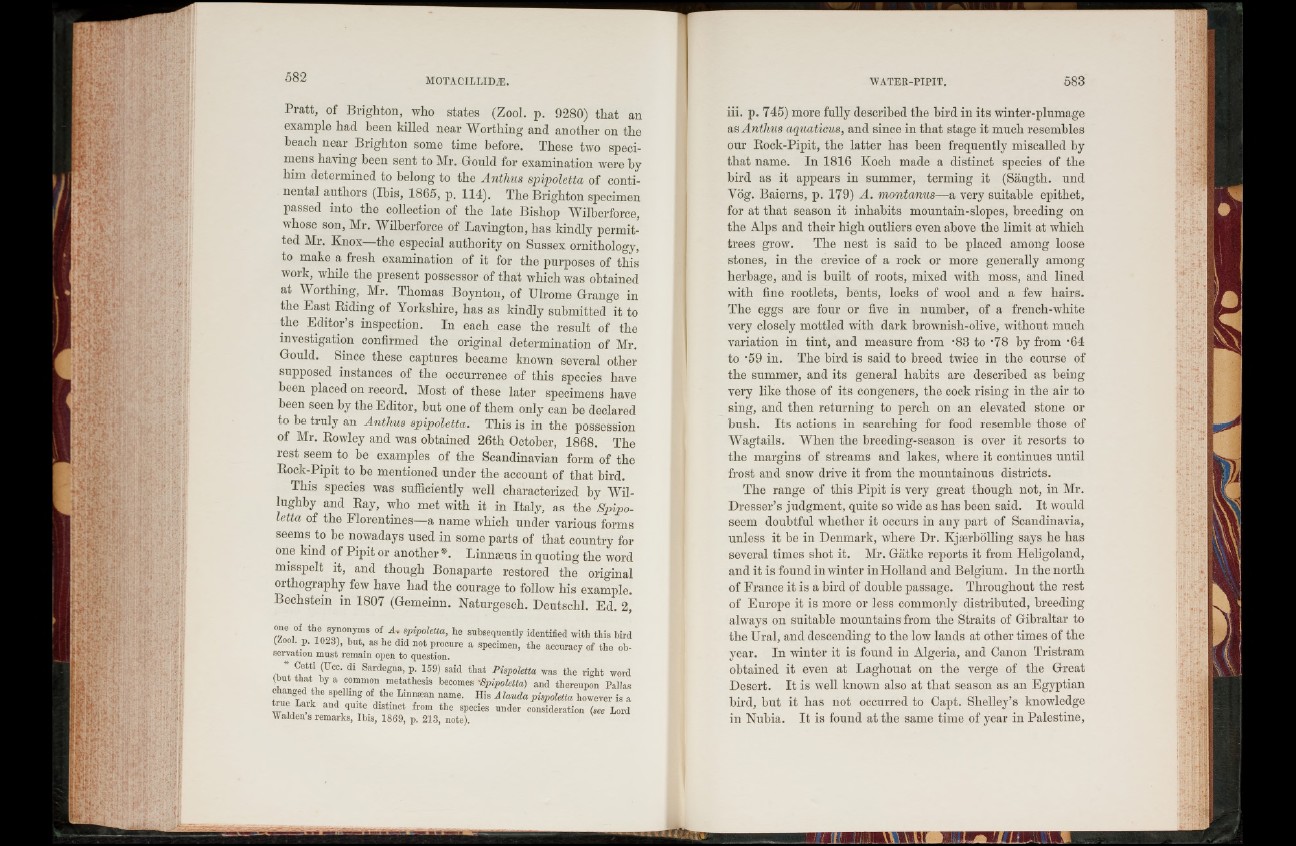
Pratt, of Brighton, who states (Zool. p. 9280) that an
example had been killed near Worthing and another on the
beach near Brighton some time before. These two specimens
having been sent to Mr. Gould for examination were by
him determined to belong to the Anthus spipoletta of continental
authors (Ibis, 1865, p. 114). The Brighton specimen
passed into the collection of the late Bishop Wilberforce,
whose son, Mr. Wilberforce of Lavington, has kindly permitted
Mr. Knox—the especial authority on Sussex ornithology,
to make a fresh examination of it for the purposes of this
work, while the present possessor of that which was obtained
at Worthing, Mr. Thomas Boynton, of Ulrome Grange in
the East Biding of Yorkshire, has as kindly submitted it to
the Editor’s inspection. In each case the result of the
investigation confirmed the original determination of Mr.
Gould. Since these captures became known several other
supposed instances of the occurrence of this species have
been placed on record. Most of these later specimens have
been seen by the Editor, but one of them only can be declared
to be truly an Anthus spipoletta. This is in the possession
of Mr. Bowley and was obtained 26th October, 1868. The
rest seem to be examples of the Scandinavian form of the
Bock-Pipit to be mentioned under the account of that bird.
This species was sufficiently well characterized by Wil-
lugliby and Bay, who met with it in Italy, as the Spipoletta
of the Florentines—a name which under various forms
seems to be nowadays used in some parts of that country for
one kind of Pipit or another *. Linnseus in quoting the word
misspelt it, and though Bonaparte restored the original
orthography few have had the courage to follow his example.
Bechstem in 1807 (Gemeinn. Naturgesch. Deutschl. Ed. 2,
one of the synonyms of A, spipoletta, he subsequently identified with this bird
(Zool. p. 1023), but, as he did not procure a specimen, the accuracy of the ob-
servation must remain open to question.
* Cetti (Ucc. di Sardegna, p. 159) said that Pispoletta was the right word
(but that by a common metathesis becomes -Spipoletta) and thereupon Pallas
changed the spelling of the Linmean name. His A lauda pispoletta however is a
true Lark and quite distinct from the species under consideration (sec Lord
Walden s remarks, Ibis, 1869, p. 213, note).
iii. p. 745) more fully described the bird in its winter-plumage
as Anthus aquations, and since in that stage it much resembles
our Bock-Pipit, the latter has been frequently miscalled by
that name. In 1816 Koch made a distinct species of the
bird as it appears in summer, terming it (Saugth. und
Yog. Baierns, p. 179) A. montanus—a very suitable epithet,
for at that season it inhabits mountain-slopes, breeding on
the Alps and their high outliers even above the limit at which
trees grow. The nest is said to he placed among loose
stones, in the crevice of a rock or more generally among
herbage, and is built of roots, mixed with moss, and lined
with fine rootlets, bents, locks of wool and a few hairs.
The eggs are four or five in number, of a french-wliite
very closely mottled with dark brownish-olive, without much
variation in tint, and measure from -88 to -78 by from -64
to -59 in. The bird is said to breed twice in the course of
the summer, and its general habits are described as being
very like those of its congeners, the cock rising in the air to
sing, and then returning to perch on an elevated stone or
bush. Its actions in searching for food resemble those of
Wagtails. When the breeding-season is over it resorts to
the margins of streams and lakes, where it continues until
frost and snow drive it from the mountainous districts.
The range of this Pipit is very great though not, in Mr.
Dresser’s judgment, quite so wide as has been said. I t would
seem doubtful whether it occurs in any part of Scandinavia,
unless it be in Denmark, where Dr. Kjserholling says he has
several times shot it. Mr. Gatke reports it from Heligoland,
and it is found in winter in Holland and Belgium. In the north
of France it is a bird of double passage. Throughout the rest
of Europe it is more or less commonly distributed, breeding
always on suitable mountains from the Straits of Gibraltar to
the Ural, and descending to the low lands at other times of the
year. In winter it is found in Algeria, and Canon Tristram
obtained it even at Lagliouat on the verge of the Great
Desert. I t is well known also at that season as an Egyptian
bird, but it has not occurred to Capt. Shelley’s knowledge
in Nubia. I t is found at the same time of year in Palestine,